
The black-bearded tomb bat is a species of sac-winged bat found in South and South East Asia.

The bicolored roundleaf bat is a species of bat in the family Hipposideridae found in Indonesia, Malaysia, the Philippines, Thailand, and Timor-Leste. This bat inhabits caves, rock crevices and tunnels among lowland forests. They roost in large numbers and consume mostly small winged insects. Their navigation and hunting skills come from the use of echolocation. Its leafnose is used to release ultrasonic shouts to distinguish its surroundings. Echolocation is also used to distinguish other species based on their wingbeat and size. The habitat of this bat decides the color of its fur. Bleaching fumes of a cave environment will cause an orange colored fur. Those who inhabit a well-ventilated roost will be a light brown color.

The intermediate horseshoe bat is a bat species of the family Rhinolophidae that is very widespread throughout much of the Indian subcontinent, southern and central China and Southeast Asia. It is listed by IUCN as Least Concern as it is considered common where it occurs, without any known major threats.

The lesser woolly horseshoe bat, also called Beddome's horseshoe bat, is a species of bat in the family Rhinolophidae. It is found in India and Sri Lanka. Its natural habitats are subtropical or tropical moist lowland forests, caves, and urban areas.

Blasius's horseshoe bat is a species of insectivorous bat in the family Rhinolophidae found throughout large parts of the Mediterranean, Middle East and Africa.
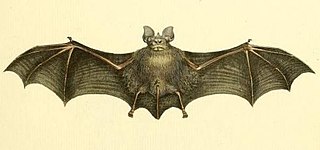
Geoffroy's horseshoe bat is a species of bat in the family Rhinolophidae found in Africa. Its natural habitats are subtropical or tropical moist lowland forest, Mediterranean-type shrubby vegetation, caves and other subterranean habitats, and hot deserts.

The Andaman horseshoe bat is a species of bat in the family Rhinolophidae. It is endemic to the Andaman Islands. During the day, it roosts in caves, but may also choose tree hollows.

The convex horseshoe bat is a species of bat in the family Rhinolophidae. It is found in Malaysia and Laos.

The Mediterranean horseshoe bat is a species of insectivorous bat in the family Rhinolophidae. It is found in the Mediterranean region and Balkan peninsula, as well as parts of Italy.

The Guinean horseshoe bat is a species of bat in the family Rhinolophidae. It is found in Ivory Coast, Guinea, Liberia, Senegal, and Sierra Leone. Its natural habitats are subtropical and tropical forests, moist savanna, caves, and other subterranean habitats.

Blyth's horseshoe bat is a species of bat in the family Rhinolophidae. It is found across southern Asia from Afghanistan to Vietnam. The species can be identified from its pointed, bifid sella.
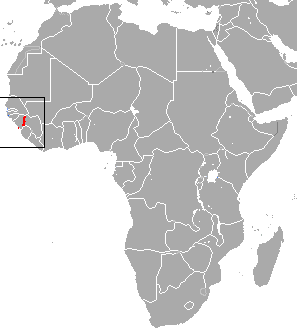
Maclaud's horseshoe bat is a species of bat in the family Rhinolophidae. It is endemic to Guinea. Its natural habitats are moist savanna, caves and other subterranean habitats. It is one of five African microbat species to be listed as endangered by the IUCN. In 2013, Bat Conservation International listed this species as one of the 35 species of its worldwide priority list of conservation. It is threatened by habitat loss.

The big-eared horseshoe bat is a bat species within the Rhinolophidae native to Asia.

The smaller horseshoe bat is a species of bat in the family Rhinolophidae. It is found in Australia and Papua New Guinea.
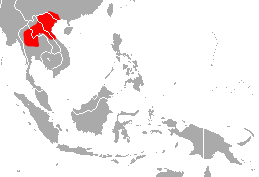
Bourret's horseshoe bat is a species of horseshoe bat native to Southeast Asia. The name "paradoxolophus" is derived from the Greek words paradoxos, meaning "contrary to expectation", and lophos, meaning "crest". This name refers to the bat's difference in nose-leaf morphology compared to other Rhinolophus species. There are no recognised subspecies.
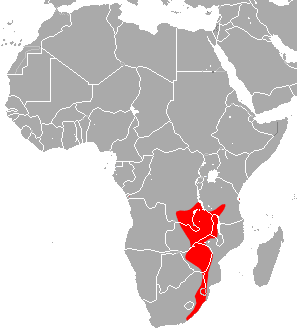
Swinny's horseshoe bat is a species of bat in the family Rhinolophidae. In English, R. swinnyi is commonly referred to as Swinny's horseshoe bat. In Afrikaans, it is commonly referred to as Swinny se saalneusvlermuis. This species belongs to the African clade. R. swinnyi was discovered by an African collector H. H. Swinny. They have been recorded in Angola, Republic of the Congo, Mozambique, South Africa, Tanzania, Zambia, Zimbabwe, and Malawi.

The Madura horseshoe bat is a species of bat from the family Rhinolophidae. Current taxonomy treats the Madura horseshoe bat as a species separate of the Sulawesi horseshoe bat and not including parvus, but Csorba et al. (2003) recognizes both as subspecies of the Sulawesi horseshoe bat. It is known only from seven specimens from Madura Island and the Kangean Islands in Indonesia, and its type locality is Soemenep, Madura Island. The species is listed as Vulnerable on the IUCN Red List, and it suffers from habitat loss due to limestone excavation and deforestation for logging and agriculture in its habitat. It is also unknown whether or not the Madura horseshoe bat lives in any protected areas. The species is cave-roosting and most likely independent of water, foraging in primary forest.
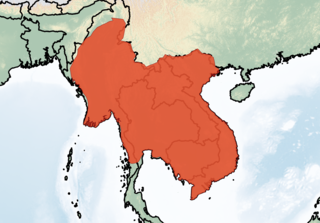
Rhinolophus microglobosus is a species of horseshoe bat found in Southeast Asia.
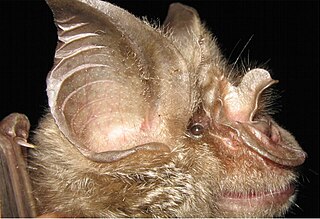
The Mozambican horseshoe bat is a species of horseshoe bat found in Africa.
McIntyre's horseshoe bat is a species of horseshoe bat that is endemic to Papua New Guinea.




















